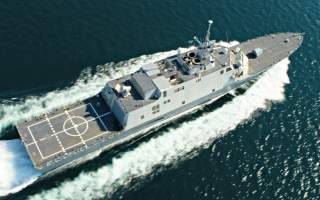The Navy’s LCS Can Finally Take-on Other Ships (And Maybe Even Win)
The Navy will soon deploy a new missile aboard its Littoral Combat Ship that can find and destroy enemy ships at distances up to 100 nautical miles.
The Navy will soon deploy a new missile aboard its Littoral Combat Ship that can find and destroy enemy ships at distances up to 100 nautical miles, service officials said.
Called the Naval Strike Missile, or NSM, the weapon is developed by a Norwegian-headquartered firm called Kongsberg; it is currently used on Norwegian Nansen-class frigates and Skjold-Class missile torpedo boats, company officials said.
“The Navy is currently planning to utilize the Foreign Comparative Testing program to procure and install the Norwegian-built Naval Strike Missile on the USS FREEDOM (LCS 1). The objective is to demonstrate operationally-relevant installation, test, and real-world deployment on an LCS,” a Navy spokeswoman from Naval Sea Systems Command told Scout Warrior.
The deployment of the weapon is the next step in the missiles progress. In 2014NSM was successfully test fired from the flight deck of the USS CORONADO (LCS 4) at the Pt. Mugu Range Facility, California, demonstrating a surface-to-surface weapon capability, the Navy official explained.
(This piece first appeared in Scout Warrior here.)
First deployed by the Norwegian Navy in 2012, the missile is engineered to identify ships by ship class, Gary Holst, Senior Director for Naval Surface Warfare, Kongsberg, told Scout Warrior in an interview.
The NSM is fired from a deck-mounted launcher. The weapon uses an infrared imaging seeker, identify targets, has a high degree of maneuverability and flies close to the water in “sea-skim” mode to avoid ship defenses, he added.
“It can determine ships in a group of ships by ship class, locating the ship which is its designated target. It will attack only that target,” Holst said.
Holst added that the NSM was designed from the onset to have a maneuverability sufficient to defeat ships with advanced targets; the missile’s rapid radical maneuvers are built into the weapon in order to defeat what’s called “terminal defense systems,” he said.
“One of the distinguishing features of the missile is its ability to avoid terminal defense systems based on a passive signature, low-observable technologies and maneuverability. It was specifically designed to attack heavily defended targets,” Holst said.
For instance, the NSM is engineered to defeat ship defense weapons such as the Close-In-Weapons System, or CIWS – a ship-base defensive fire “area weapon” designed to fire large numbers of projectiles able intercept, hit or destroy approaching enemy fire.
CIWS is intended to defend ships from enemy fire as it approaches closer to its target, which is when the NSM’s rapid maneuverability would help it avoid being hit and proceed to strike its target, Holst added.
Holst added that the weapon is engineered with a “stealthy” configuration to avoid detection from ship detection systems and uses its sea-skimming mode to fly closer to the surface than any other missile in existence.
“It was designed against advanced CIWS systems. It is a subsonic weapon designed to bank to turn. It snaps over when it turns and the seeker stays horizontally stabilized -- so the airframe turns around the seeker so it can zero-in on the seam it is looking at and hit the target,” he said.
Raytheon and Kongsberg signed a teaming agreement to identify ways we can reduce the cost of the missile by leveraging Raytheon’s supplier base and supplier management, Holst explained.
Kongsberg is working with Raytheon to establish NSM production facilities in the U.S., Ron Jenkins, director for precision standoff strike, Raytheon Missile systems, said.
Kongsberg is also working on a NSM follow-on missile engineered with an RF (radio frequency) sensor that can help the weapon find and destroy targets.
The new missile is being built to integrate into the internal weapons bay of Norway’s F-35 Joint Strike Fighter.
Kongsberg and Raytheon are submitting the missile for consideration for the Navy’s long-range beyond-the-horizon offensive missile requirement for its LCS.
“The Navy has identified a need for an over-the-horizon missile as part of their distributed lethality concept which is adding more offensive weapons to more ships throughout the fleet and they wanted to do this quickly,” Holst explained.
The Navy's distributed lethality strategy involves numerous initiatives to better arm its fleet with offensive and defensive weapons, maintain a technological advantage over adversaries and strengthen its "blue water" combat abilities against potential near-peer rivals, among other things.
They are pitching the missile as a weapon which is already developed and operational – therefore it presents an option for the Navy that will not require additional time and extensive development, he said.
“The missile is the size, shape and weight that fits on both classes of the Littoral Combat Ship,” Holst said
Kris Osborn became the Managing Editor of Scout Warrior in August of 2015. His role with Scout.com includes managing content on the Scout Warrior site and generating independently sourced original material. Scout Warrior is aimed at providing engaging, substantial military-specific content covering a range of key areas such as weapons, emerging or next-generation technologies and issues of relevance to the military. Just prior to coming to Scout Warrior, Osborn served as an Associate Editor at the Military.com. This story originally appeared in Scout Warrior.
Image: U.S. Navy

